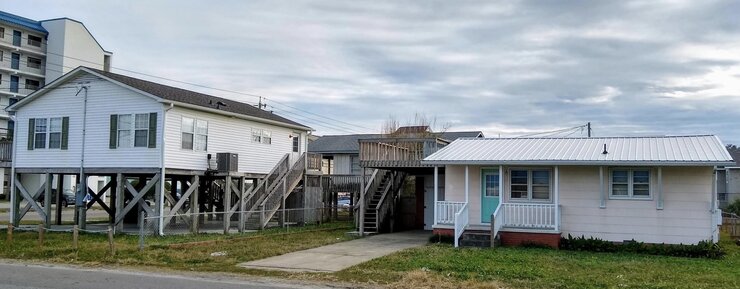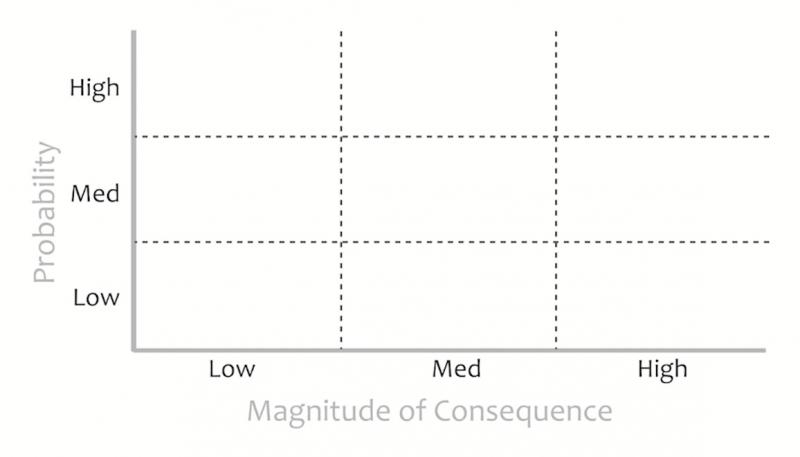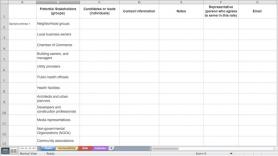Assess Vulnerability & Risk
To characterize the risk represented by your exposed assets, you'll plot the probability that the hazard will occur against the magnitude of the potential loss it would incur.
Some groups complete their own assessment process. Others hire professional climate adaptation practitioners to help them conduct a Vulnerability & Risk assessments.
Understanding Vulnerability
Looking over your list of exposed assets, you'll probably notice that some assets are more likely to be damaged than others. Another concept—vulnerability—can help determine which assets are most and least likely to be harmed. The assets that are likely to be negatively impacted by one or more climate-related hazards are vulnerable.
Clarifying our Vocabulary
Below are the descriptions we use for concepts related to vulnerability and risk. Discussing and referring back to these definitions can help groups communicate clearly as the develop a common understanding of the processes.
Sensitivity
To determine if an asset is vulnerable, you'll first consider its sensitivity to the hazards it is exposed to. Is the hazard capable of damaging the asset?
- If an asset could sustain a negative impact from a hazard, it is sensitive to that hazard. For example, a ground-floor furniture store would be considered sensitive to flooding.
- If the potential impact from a hazard is minimal, the asset is not sensitive. For example, assets such as parking lots are generally not sensitive to severe weather.
Adaptive Capacity
Even if an asset is sensitive to a hazard, it is not necessarily vulnerable. Does the asset have adaptive capacity—a characteristic that helps it deal with or adjust to the hazard? For example, does the ground-floor furniture store have flood barriers installed at every door to the building?
Adaptive capacity—the ability to adjust to new situations—reduces the potential impact of a sensitive asset. For each asset-hazard pair, consider if the asset has some ability to avoid damage or adapt to an occurrence of the hazard.
Vulnerability
Make a new list of you exposed assets and add three columns to the right. Label them Potential Impact, Adaptive Capacity, and Vulnerability.
To judge the vulnerability of each asset to the indicated hazard,
- Describe the potential impact of the hazard on the asset in the first column.
- Describe any adaptive capacity that the asset has in the second column.
- Based on your descriptions, consider how likely it is that the asset would be damaged if the hazard occurs. Use the third column to categorize the vulnerability of each asset-hazard pair as low, medium, or high.
Understanding Risk
For assets with high or medium vulnerability, you'll also want to characterize the risk they represent. Risk is a compound concept that describes the chance of sustaining a substantial loss.
- The first element of risk is the probability of a hazard occurring. How likely is it that the hazard will happen in your location? How frequently has it occurred in the past, and is that frequency increasing due to climate change?
- The second element is the magnitude of consequences from the event. Would the hazard cause a major disruption for a large number of people for an extended period? Would it require large amounts of money and time to regain the previous level of function?
When referring to risk from weather and climate-related hazards, higher risk reflects either a higher chance of a hazard occurring or a higher cost (financial or otherwise) if the hazard occurs. To characterize risk, you'll rate these two parameters for each of your exposed assets.
Estimate the probability of a hazard
For the hazards that could impact your most vulnerable assets:
- Collect information on how frequently the hazard has occurred in your region in the past.
- Check if climate change or other stressors are likely to increase the frequency or severity of the hazard over time.
Digital tools and data available through this site can help you find the answers to these questions. For instance, you can explore past and current conditions or check applied forecasts.
Based on what you find, estimate the probability a hazard will occur as low, medium, or high. Develop a simple rule set for the three categories to ensure that you apply probability consistently.
Example rule set for categorizing probability:
If a hazard is likely to occur within 5 years, designate it as a high probability. Categorize events that are likely to occur just once in 5 to 20 years as medium probability. Designate events that are likely to occur less frequently than once in 20 years as low probability.
Estimate the magnitude of a loss
Gather available information to help you estimate or illustrate the financial and social costs of the loss you would experience if the hazard occurs. To get started, explore the losses that resulted from recent hazards in other places or find out what it took for communities to recover from hazardous events that occurred a decade or more ago.
Again, develop a simple rule set to help you categorize the magnitude of a loss as low, medium, or high.
Characterize risk
For every exposed asset, plot the probability of the hazard and the magnitude of the loss on a 3x3 matrix like the one shown on the right. Assets that plot in the High-High or High-Medium areas of the matrix represent your highest chances of sustaining a substantial loss.
Check FEMA's National Risk Index
Do you need to hire a consultant?
Be aware that many communities choose to hire consultants, adaptation practitioners, or Architecture and Engineering (A&E) firms to assist them in compiling their vulnerability and risk assessments. Professionals who fill these roles still need plenty of input from the local champion and team, but they can help groups navigate unfamiliar concepts to document the most pressing potential climate problems in your community.
Qualititative or Quantitative?
Communities often begin using qualitative methods for their assessment, categorizing vulnerability and risk as low, medium, or high. This approach is fairly quick and effective for identifying which assets represent your highest risk. When setting priorities for the most important parts of a complex system, groups often choose to do the extra work it takes to quantify vulnerability and risk.
To zero in on specific locations where resilience-building can benefit the entire community, many efforts access detailed spatial information and quantitative data on hazards and property values. To work in a real community, this quantitative information about physical assets needs to complemented by social awareness and a commitment to keep equity at the center of all decisions.
Quantitative geospatial information may be available as web-accessible map layers. Data available in this format make it relatively easy to calculate and display measures of vulnerability and risk across the community. Maps produced using these methods can display the severity of potential hazards and highlight locations where risk is high. Using a map-based quantitative approach also helps reduce uncertainty, making it easier for your team and decision makers to set priorities.
Where should you start?
In general, groups address their highest risk first. However, if you recognize that damage to a specific asset (for example, a heavily used bridge or your telecommunications capacity) could initiate multiple failures across other sectors in your community, consider that asset as a top priority. Think about the things your community truly depends upon to function, and use that knowledge to set your priorities.
Decision point
Can you accept the risk climate presents to your assets? If not—continue to Investigate Options »
Instructions on these pages encourage you to gather specific types of information. You may find it convenient to download this prepared spreadsheet and use it to record input as you move through the steps.
Access the Steps to Resilience Glossary for definitions and examples of words related to resilience.







